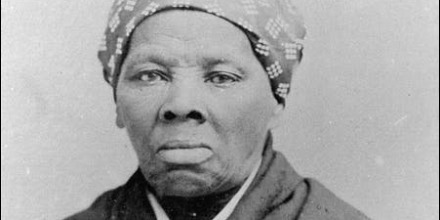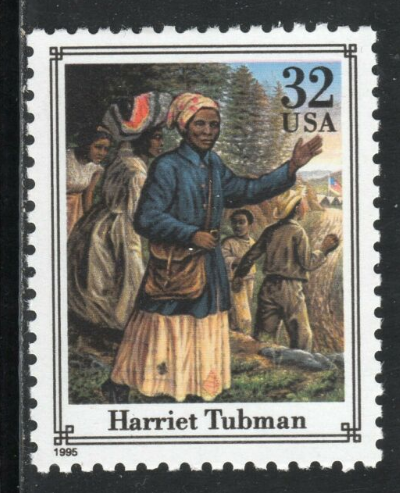Fugitive slave Harriet Tubman went back to slave-holding territory 19 times after Congress passed The Fugitive Slave Act of 1850. In total, she brought 300 slaves to their freedom before The Civil War. Thus, many of Tubman's contemporaries considered her, "The Moses of her people."
Of course, the federal prosecutors of the day likely would've thrown the book at Tubman. Rewards for her capture totaled to $40,000---equivalent to over $1 million today (adjusted for inflation and the Consumer Price Index).
To call Tubman ahead of her time is an understatement. The Republican Party wasn't formed until February 28, 1854 (specifically to oppose the expansion of slavery). The Supreme Court decided Dred Scott in 1857, and Abraham Lincoln was elected president in the 4-way race of 1860. Although some states seceded earlier, the Confederacy formed February 8, 1861, less than a month before Lincoln's inauguration. So, for over a decade before The Civil War and the effective date of The Emancipation Proclamation on January 1, 1863, Tubman risked life and limb to help others gain freedom.
Tubman then joined the Union Army as a nurse, scout and spy. On one mission, she helped free a further 750-plus slaves. In his letters, diehard abolitionist John Brown called her, "General Tubman."
Following the war, Tubman continued outpacing her times. She established her residence as The Home for Indigent and Aged Negroes and she advocated for women's suffrage. She died in 1913, around age 90, about 7 years before The Nineteenth Amendment guaranteed women the right to vote.
The U.S. government---in stark contrast---hasn't been nearly as timely in paying proper respect to Tubman. As The Encyclopedia Britannica noted in 2005, Tubman, "spent her last years in poverty. Not until 30 years after the war was she granted a government pension in recognition of her work for the [Union's] Federal Army."
Then, the U.S. Postal Service waited until 1978---some 65 years after Tubman's death---to issue a postage stamp in her honor.
The 32-cent Harriet Tubman U.S. postage stamp was issued in 1978, sixty-five years after Tubman's death; eBay
A new $20 bill bearing Tubman's image was originally slated to enter circulation today, on the hundredth anniversary of the ratification of The Nineteenth Amendment. But, as Mr. Deroy Murdock noted here, as well as in the February 2020 print edition of Newsmax, The U.S. Treasury Department cited difficulties with anti-counterfeiting measures and delayed its debut until as early as 2026---long after President Trump leaves office and 113 years after Tubman's death.
Because changing the $20 bill is such a long process, Mr. Murdock proposed an alternative: let Andrew Jackson keep the twenty and issue a new $25 bill for Tubman.
As Mr. Murdock rightly noted, Tubman's legacy deserves to stand on its own, free from the baggage of replacing another historical figure on a bill.
Creating a new denomination, however, has disadvantages. Cash registers, automated checkout machines, ATMs, and other machines would require costly and time-consuming physical and software changes, like adding a new slot to cash drawers and updating software to scan and accept the new bill. All this would need to be done before it entered circulation. At the pace of the Washington bureaucracy, this could easily take longer than changing the twenty.
Thus, creating a new denomination is untenable. And---to put it mildly after the previous delays---waiting until 2026 to honor Tubman would be unseemly.
So what's the solution?
Another idea is to issue a new coin. Coin machines operate by weight and dimensions, so software updates and physical changes would be unnecessary. Machines easily accepted bicentennial quarters, for example, and the Treasury seamlessly issued a slew of new quarters, including one for each of the 50 U.S. states.

eBay
Further, even if Tubman replaced George Washington on the U.S. quarter, he'd still have the $1 bill. So, perhaps he could spare a denomination, unlike other historical figures.
The quarter is also ubiquitous and therefore prominent---at least for now. But coins are increasingly getting the cold shoulder as wages and prices rise. Surely the foreword-thinking and courageous Harriet Tubman deserves a larger denomination too, and not a coin that may soon go the way of the dinosaur. (As Mr. Murdock further noted, Tubman's $25 bill would be $5 larger than Jackson's twenty.)
A $1 coin would award Tubman a larger denomination without the headaches of a new bill. Plus, railroad-ticket machines already make change with $1 coins, so modern railroad passengers would often be reminded of the noteworthy underground-railroad conductor.
On the downside, Americans rarely use $1 coins anymore. Further, Susan B. Anthony and Sacagawea already have $1 coins. Thus issuing another for Tubman would further dilute their significance and put Tubman in an already-crowded place near obsolescence on its very first day.
Moreover, even if a spot could be made for Tubman somewhere on our physical currency, similar problems would persist for other historical figures who remain overdue and passed-over by The Treasury Department. People will ask, "What about Teddy Roosevelt?" (Or Martin Luther King Jr., F.D.R., Reagan, J.F.K., Eisenhower, and other notables who remain un-noted.) Tubman should lead the way for them too, out of this D.C.-based quagmire of inaction and half-measures, just as she did on the underground railroad.
Enter cryptocurrency and its most prominent form: bitcoin. Bitcoin and digital currencies, known collectively as cryptocurrenices, are a new type of commodity based upon mathematics and computing power. Unlike the U.S. dollar and other so-called fiat currencies, nobody can simply print more bitcoins; instead, they must be "mined" by performing trillions of mathematical calculations in coordination with the blockchain, a real-time ledger maintained by computers all over the globe. Once mined, bitcoins can be traded for real goods and services and national currencies like the U.S. dollar. Transactions are completed in seconds, usually with smartphones.
The U.S. Treasury has for some time wearily eyed cryptocurrency. Like many technologies, the federal bureaucracy likely never would adopt it if left to its own devices. Instead, it will have to be dragged kicking and screaming into the twenty-first century. Indeed, all but inevitably we'll have to adopt some form of official digital currency alongside paper bills and coinage. The first nation to do so stands to gain the most.
But which of the many cryptocurrencies fits best? Bitcoin is by far the most popular, so it enjoys several competitive advantages.
Foremost, perhaps, is liquidity (it's easiest to trade bitcoins because more people have them and want them), followed by existing infrastructure (it's easiest to trade bitcoins because more people and businesses are setup to use them). Bitcoin further enjoys the widest brand recognition, and, perhaps, the most trust. It also has the less-obvious merits of resiliency (it's less likely bad events would entirely eliminate the supply and demand for bitcoin) and being the best tested (any catastrophic failure likely would've happened already). The continuing speed of bitcoin's adoption is also the fastest, and as a result its value will continue stabilizing.
Despite its daily fluctuations, critics of bitcoin's current and past volatility may note (or lament) that each 100 dollars invested in bitcoin a decade ago is now worth $9.2 million.
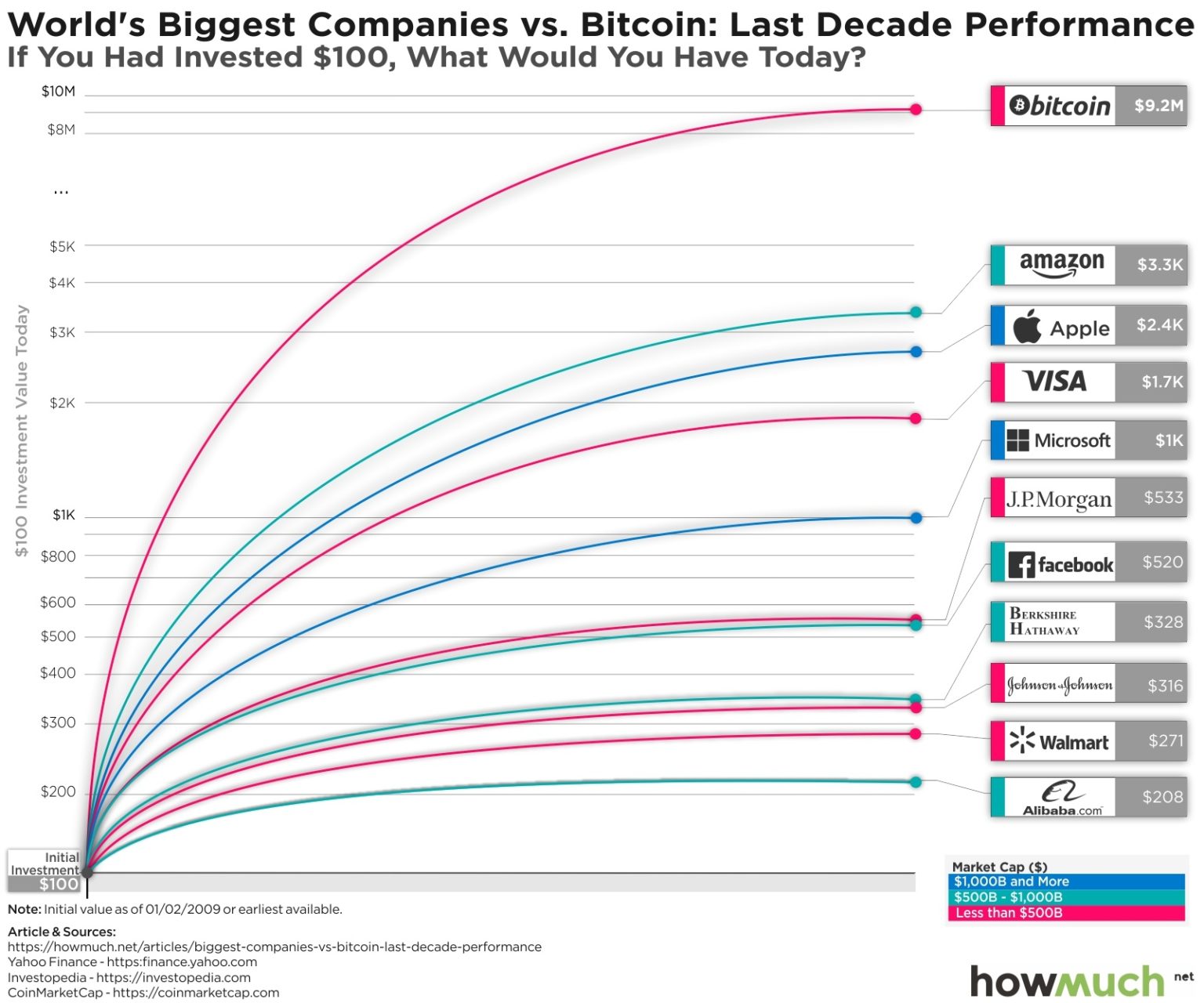
Bitcoin is surely volatile, but over the past decade it trounced the stock markets, the U.S. dollar, and the prices of gold and other commodities; Howmuch.net
From another angle, critics of deficits, The Federal Reserve, and fiat currencies (read: inflatable money) note that nobody---not even the government---can simply print more cryptocurrency. Creating (or "mining") bitcoins takes time, computing power, electricity, Internet access, and coordination. In short, like the gold standard, cryptocurrency can keep the Fed honest---so perhaps it's no wonder the Fed seems loathe to the concept.
But cryptocurrencies have a happy problem with denominations---one Tubman could solve 107 years after her death: An individual bitcoin, commonly written 1 BTC, is growing so valuable that most consumer transactions use smaller and smaller fractions of 1 BTC. It's like reverse-inflation, and it's gone from the point over a decade ago when 1 BTC was worth less than a dollar, to today, with prices of everyday items commonly written in mBTC, or thousandths of a bitcoin (1000 mBTC = 1 BTC).
Coupled with this, it's difficult for bitcoin owners to stay abreast of the true value of their digital wallets. Someone who purchased 1 BTC a decade ago for $0.39 and held it all this time would still see the same 1 BTC in her digital wallet today, although it's now worth $11,789.55, about 30,229 times more. Thus, most bitcoin owners use the conversion rates between the BTC and their national currencies to appraise their bitcoins. This defeats one of bitcoin's core advantages by forcing its owners to value it in terms of easily-manipulated government currencies with neither intrinsic worth nor scarcity.
In short, prices of goods and services continue to be anchored to fiat currencies instead of any truly-meaningful measure of buying power (for example, the McDonald's Dollar Menu). And bitcoin is far from such common acceptance (as yet there's no 0.1-mBTC Menu at any fast-food chain).
American businesses that accept bitcoins usually set prices in dollars and use the conversion rate to float prices in BTC. For example, if hotel rooms each cost $100/night and the conversion rate changes 1 percent over an afternoon from $1/mBTC to $1.01/mBTC, then a customer who uses BTC to book a room earlier in the afternoon would spend 100 mBTC, slightly more than a later customer who books an equivalent room from about 99 mBTC.
The hotel owner, meanwhile, likely immediately traded the BTC from both transactions for dollars---as do most businesses that accept bitcoin. In the process, though, the owner first missed out on the percentage-point gain in BTC that followed the earlier transaction, then he accepted a lower price for the second transaction than if the room's rate had been set in BTC, and finally he missed out on any future gains in BTC after the second transaction.
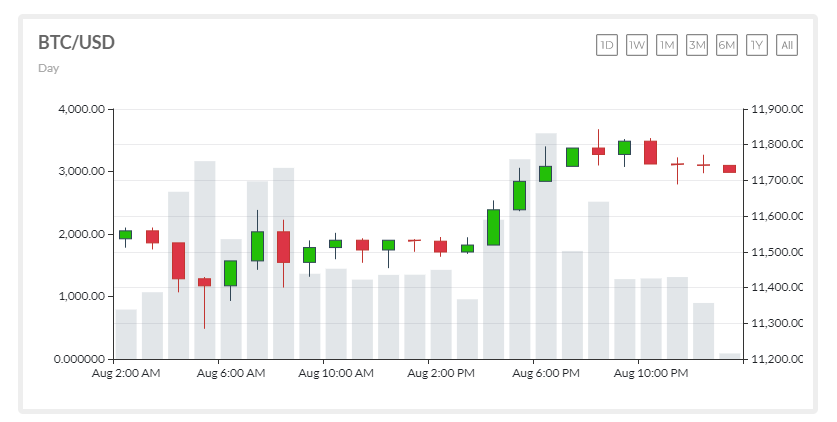
The exchange rate between BTC and the U.S. dollar, like that between any 2 currencies, changes throughout the day; for example, this is graph shows the BTC-U.S.-dollar exchange rate from a few days before publication, August 13; masterthecrypto.com
Now, some would argue the hotel owner avoided risk by immediately getting rid of the bitcoins. Given that bitcoin has trounced the dollar for over a decade, however, the hotel owner really risked far more by picking up the dollars and he also lost out on the future gains of the BTC. It is a simple, immutable, and objective truth that over the past decade the price of milk has increased in dollars and fallen in BTC. (Or, put another way, the value of the dollar decreased in terms of milk while the value of BTC increased in terms of milk.)
Yet, today's businesses continue trying to ascend the downward escalator while the federal debt and deficits soar and The Federal Reserve devalues the dollar, literally manufacturing trillions from thin air. In contrast, no central bank can change the scarcity of the BTC.
But where does Harriet Tubman fit into this?
New denominations of value---and not currency---are needed to represent true buying power. One such unit should be the Tubman.
These units must be anchored to a worldwide index that averages the values of every commonly-traded real commodity, e.g. gold, silver, crude oil, diamonds, platinum, timber, etc. This would factor out the so-called "value" of the fiat currencies and proportionalize the impact of price changes in any one commodity or market.
Prices could then be set using these new denominations. That $100/night hotel room could also be offered for 100 Tubmans/night, an amount which could be written T100.
Likewise, wallet software could be updated to query the Internet automatically for the actual value of the BTC (or other cryptocurrency) in Tubmans. It would then display the values of cryptocurrency wallets in BTC, domestic fiat currency, and Tubmans.
The BTC amount displayed in a wallet would change only when the wallet's owner buys and sells things. The value displayed in Tubmans would change with the actual value of the BTC. Bitcoin owners would continue to hold front-row seats as the domestic fiat currencies decline as a result of government economic policies as compared to both BTC and Tubmans (for example, according to the Consumer Price Index, what cost 10 cents in 1915 costs $2.57 today).
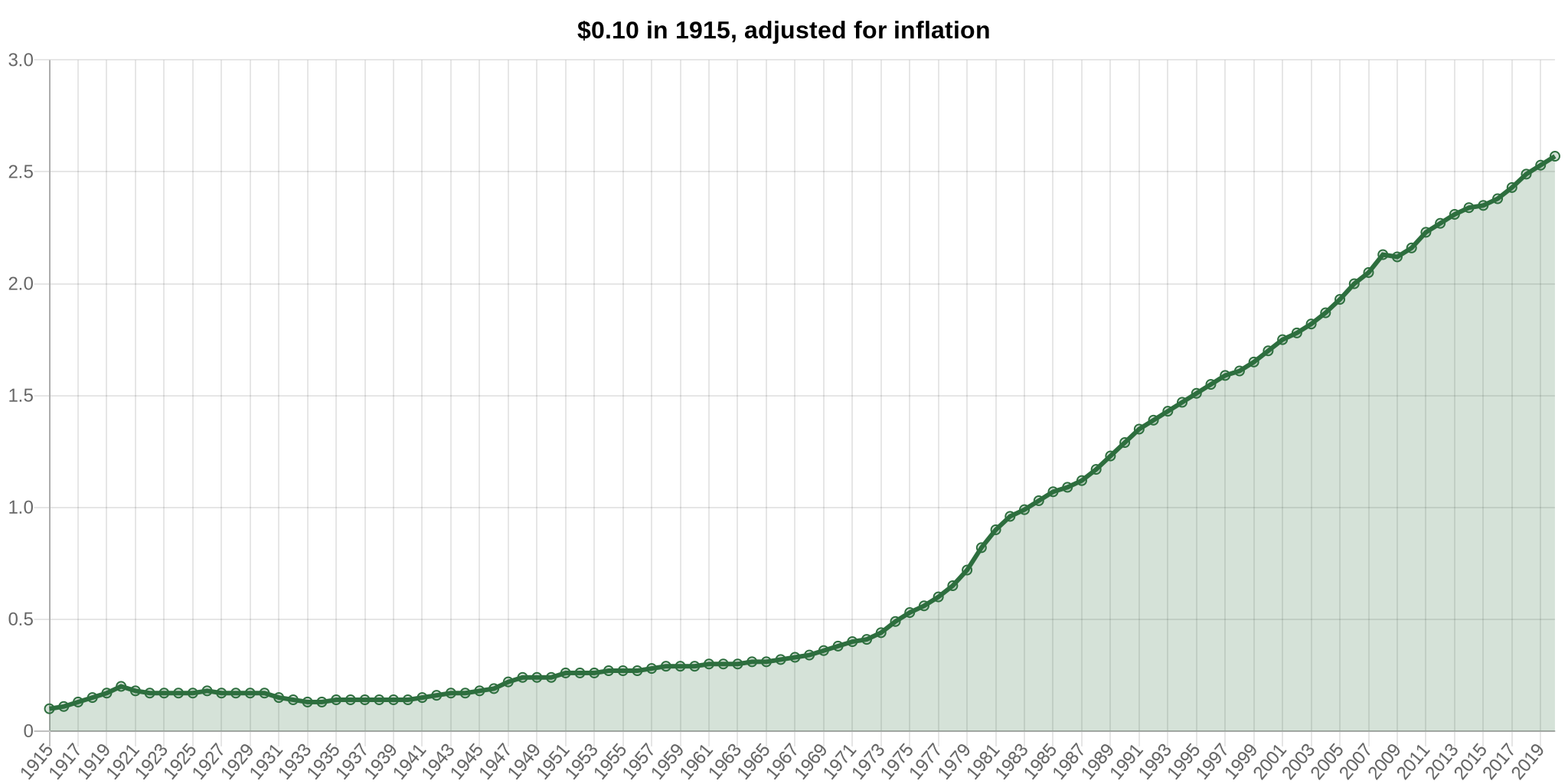 in2013dollars.com
in2013dollars.com
Thus, the Tubman and its sister denominations would function as a new kind of gold standard, independent of every national fiat currency and cryptocurrency. Finally, there would be a true and universally-accessible separation between currency and valuation. With this separation would come unprecedented accountability for The Federal Reserve and other fiat banks. This accountability would intensify as more people caught frequent glimpses of the true impacts of monetary policies on the buying power in both their physical and virtual wallets.
Further, since this concept is digital, it can be "localized," as computer programmers say. This is vital to spurring adoption---and thereby also accountability---on an international level. "Localization" means software in The United States can label the unit the "Tubman" while software in The United Kingdom can call it the "Churchill." And for another example, software in France could call it a "de Gaulle."
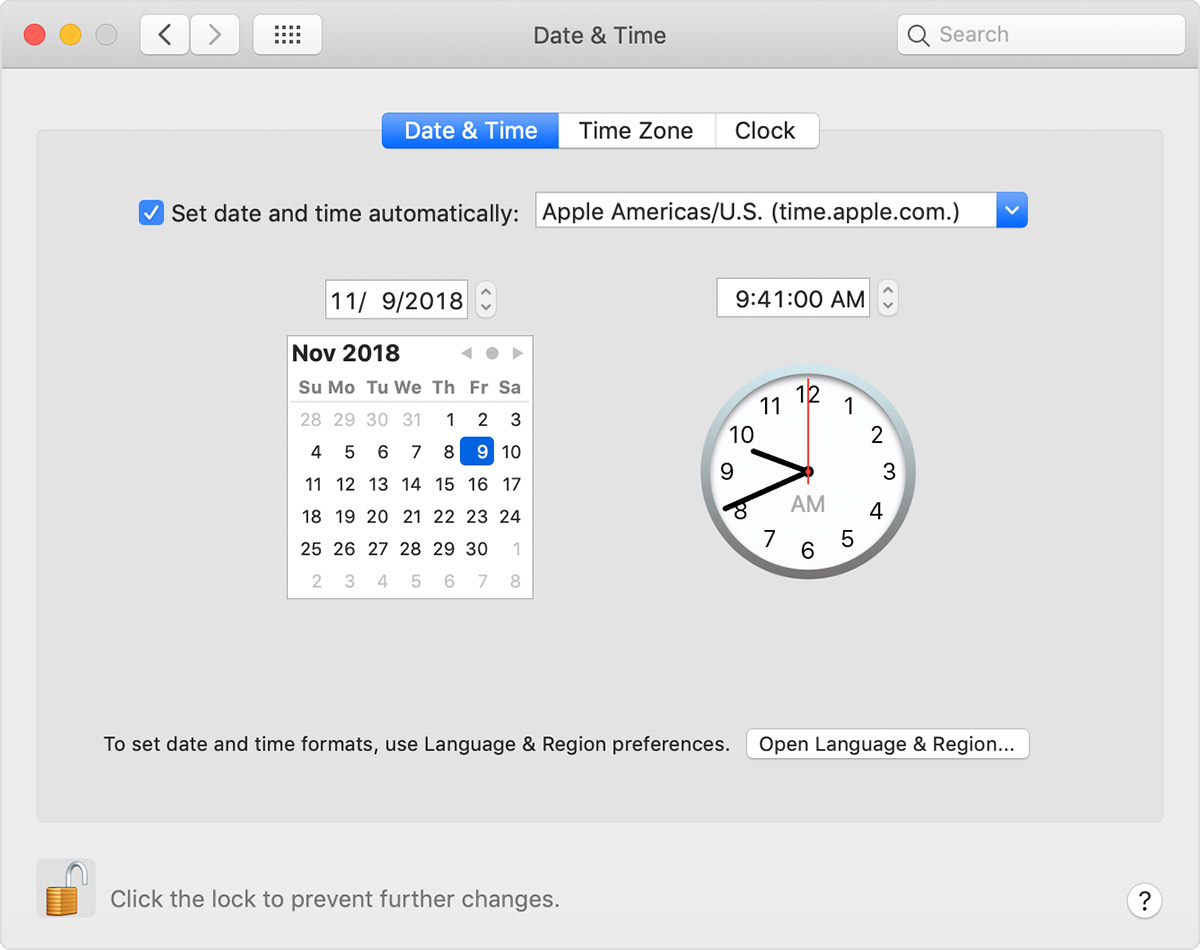
Software localization allows computers to present purely digital values, like dates and times, in whatever format is customary in a given locale.
Computers, in such an example, would know a Tubman, a Churchill, and a de Gaulle are all the same and the local labels wouldn't matter. When an American and a Brit trade, there would be no need for the American to know that on the other side of the pond the same unit is called a Churchill, or vice versa.
Some morning in the not-too-distant future, when The Federal Reserve Bank and The Bank of England have coordinated on some unfortunate and misguided monetary policy, an American might wake up, check her bitcoin wallet, and note, "Wow, the Tubman really outdid the dollar yesterday."
Meanwhile, her British counterpart may check her bitcoin wallet and say, "The Churchill is doing bloody great against the pound!"
In closing, Harriet Tubman was a great American. The Treasury Department is long overdue to recognize her properly.
Tubman was born into slavery in Maryland, not far from the nation's capital. She was originally named Araminta Ross, but she became known by her mother's first name: Harriet. In 1844, she married a free African-American named John Tubman, taking his surname.
Tubman was a lifelong and devout Christian. In setting free hundreds from slavery, she found help from other Christians, especially Quakers.
Tubman was also an outdoorsmen. Her father taught her survival skills that proved vital to her success. In 19 or more trips back into slave-holding territory, including to free her family, she had many close calls, including one with her former slave-holder.
Before Tubman escaped, a slave-holder fractured her skull with a metal weight, when, as a child, she tried to stop the beating of another slave.
Tubman also famously carried a revolver and promised to use it to ensure her safety and the success of her missions.
If The Treasury Department isn't ready to honor Tubman, then it's only fitting her name carry on in a manner that increases public scrutiny of both the department and The Federal Reserve---which has been anything but reserved in devaluing the U.S. dollar and the life savings of generations of Americans.
Marty Gottesfeld is a Senior systems engineer, imprisoned human-rights activist, and alleged Anonymous hacker. His writing on federal-prison conditions and criminal-justice matters has been featured by HuffPost, Newsweek, Red State, WND, Info Wars, The Western Journal, The Intercept, and The Liberty Sentinel. Follow him on Facebook and Twitter @FreeMartyG and on his website, www.FreeMartyG.com.

 Donate Now
Donate Now
 Follow
Follow 